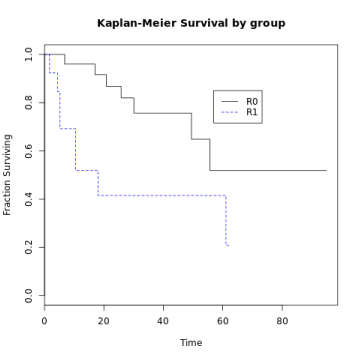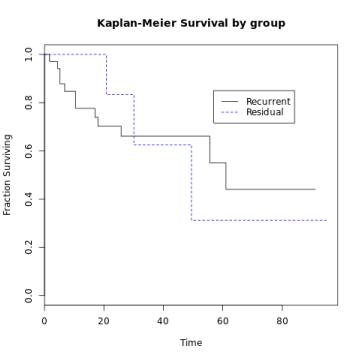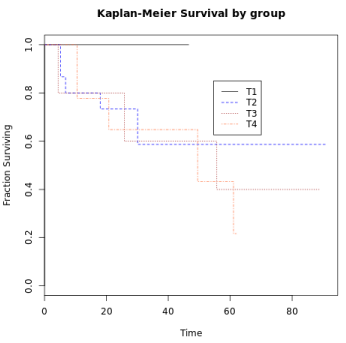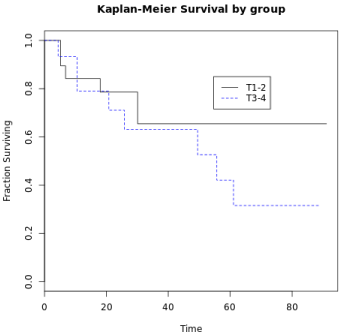Journal of Surgery and Surgical Research
Outcomes of surgery following chemoradiotherapy for anal cancer: A 10-year retrospective study
Ioannis Leptidis1*, Paul A Sutton1, Se Hwang Liew2 and Paul S Rooney1
2Department of Plastic Surgery, St Helens and Knowsley Hospitals NHS Trust, UK
Cite this as
: Leptidis I, Sutton PA, Liew SH, Rooney PS (2021) Outcomes of surgery following chemoradiotherapy for anal cancer: A 10-year retrospective study. J Surg Surgical Res 7(1): 062-066 DOI: 10.17352/2455-2968.000139Introduction: Treatment for Anal cancer is carried out in regional cancer centres but when chemoradiation fails or is ineffective then there is a role for salvage surgery but carries considerable morbidity and mortality. We reviewed clinicopathological outcomes for patients undergoing surgery following Chemoradiotherapy (CRT) for anal cancer.
Materials and methods: A retrospective review of patient data from patients undergoing surgery for anal cancer from 2008 -2018 was performed. Patients were identified from the anal cancer MDT records and the departmental surgical logbook.
Results: Forty patients were identified (72.5% female) with a median [IQR] age of 62 [18.25] years. Thirty-three patients underwent APER and seven underwent pelvic exenteration, with 25 (62.5%) having flap reconstruction of the perineum. Post-operative complications were identified in 25 (62.5%) patients, 18 (72%) of which were Clavien-Dindo I-II and 7 (18%) were III-IV. There was one 90-day mortality. The overall 1, 3, and 5-year survival was 76.4%, 47.8% and 35.2% respectively.
Conclusion: Chemoradiotherapy remains the gold standard for the treatment of anal cancer, with salvage surgery preserved for cases of residual or recurrent disease, or for palliation. We report a median time from completion of CRT to surgery of 12 months, an R0 resection rate of 70%, and 5-year survival of 35.2%. The reason for low 5-year survival requires analysis. Robust prospective data collection is needed to fully quantify outcomes in this important group.
Abbreviations
UKCCCR: United Kingdom Co-ordinating Committee on Cancer Research; HPV: Human Papilloma Virus; MDT: Multidisciplinary Teams; AF: Atrial Fibrillation; NSTEMI: Non-ST Segment Elevation Myocardial Infarction; DVT: Deep Vein Thrombosis; COPD: Chronic Obstructive Pulmonary Disease; VRAM: The Vertical Rectus Abdominis Musculocutaneous; TRAM: Transverse Rectus Abdominus Muscle; 5FU: Fluorouracil; Gy: Gray (radiation unit); CT scan: Computerized Tomography (CT) scan; PET-CT: Positron Emission Tomography–Computed Tomography; MRI: Magnetic Resonance Imaging; CRT: Chemoradiotherapy; IQR: Interquartile Range
Introduction
Anal Cancer is a very rare disease which leads to an uncontrolled growth of the cells at the anal canal or the anus. It consists 2% of all cancers. It affects women more than men and it is associated with the Human Papilloma Virus (HPV) which is the most common risk factor for this disease along with smoking and immunosuppression [1].
Following the first UKCCCR Anal Cancer Trial in 1996, the gold standard for treatment is Chemoradiotherapy [2,3]. Depending on the response to primary treatment, during the follow up, the patients will be classified in 3 groups: Complete Remission Group (full respond to treatment), Persistent/Residual Disease Group (partial respond to treatment) and Recurrent Disease Group (no respond to treatment).
More specifically, the presence of carcinoma up to 6 months following the completion of primary treatment is defined as Residual Disease, whereas the presence of carcinoma after to 6 months is defined as Recurrent Disease [4].
Salvage surgery has been reserved for cases of residual or recurrence disease. This operation involves the removal of the anus, the rectum and a part of the sigmoid colon followed by the creation of an end colostomy. Several patients will also require reconstruction of perineum with flap.
In our study we aimed to review the outcomes for patients who underwent salvage surgery following chemoradiotherapy for anal cancer.
Materials and methods
A 10-year retrospective study was conducted in December 2017. We reviewed the clinicopathological outcomes for patients who underwent surgery following chemoradiotherapy for anal cancer from 2008 to 2018 at the Royal Liverpool and Broadgreen University Hospital (Audit Registration Number: TA0001664).
Prior of the discussion at the Anal-MDT, each case underwent CT scan and MRI-Pelvis. The majority of the cases received radiotherapy of 50.4Gy in 28 fractions in two phases over a period of 5.5 weeks. This was combined with chemotherapy (Mitomycin C and 5FU in week 1 and 5FU in week 5). Patients with metastatic disease were treated with combination of Cisplatin and 5FU.
Six months from completion of chemoradiotherapy all patients underwent MRI scan of Pelvis.
The cases were identified through the Anal MDT Records and the Departmental Surgical Logbook. The inclusion criteria for our database were histopathologically confirmed Recurrent or Residual disease cases of Anal Cancer which following chemoradiotherapy required Salvage Surgery.
Patients’ demographics, age, gender, medical co-morbidities, past surgical history, primary treatment, post-operative complications, flap reconstruction of perineum, staging, presence of groin disease and time from Chemoradiotherapy to Surgery were evaluated.
The survival analysis was performed by Kaplan–Meier method by using Statsdirect software.
Results
Overall, 460 cases of Anal Cancers were identified. Out of them, we retrieved the notes for 40 cases which underwent surgery and they were eligible for our study.
Patients’ characteristics
The mean age was 62 years old (m:f 11:29). Three patients were Type 2 diabetics, two patients had been diagnosed with liver cirrhosis, four had significant cardiac history (AF, NSTEMI, angina, myocardial infarction and coronary stents), one patient had previous history of DVT and one patient had history of COPD.
T stage and type of disease
Radiological staging was used for this study. This was based on CT scan, MRI scan and PET-CT scan. Histopathological staging was not included in any of the histology reports. Six out of forty cases were identified as Residual Disease and thirty-four as Recurrent disease. Four cases were T1 stage, seventeen cases T2, five cases T3 and ten cases T4. For four cases we were not able to retrieve information with regards of the T stage [Table 1].
Type of surgery and R rate
The operations were performed by two senior Consultant Colorectal Surgeons. Thirty-three patients underwent Salvage Abdominoperineal Resection and seven Pelvic Exenteration. In total, twenty-five patients (62.5%) required flap reconstruction of the perineum: 13 Vertical Rectus Abdominis Myocutaneous Flap (VRAM), 2 Transverse Rectus Abdominis Myocutaneous flap (TRAM), 8 Gluteal flap and in 2 was the flap was not specified.
The R0 rate was 70% (28 out of 40), while the R1 rate was 30% (12 out of 40). For the cases of residual disease, the R0 rate was consistent with 100% (6 out of 6 cases). Eight cases had R1 resection (all eight of them had been diagnosed with recurrent disease). Therefore, the R1 rate was 0% (0 out of 6) and 35% (12 out of 34) for residual and recurrent disease respectively [Table 2].
Morbidity and mortality
Post-operative complications were identified in 25 patients (62.5%) in total. Out of the twenty-five cases, eighteen cases (72%) were Clavien-Dindo I-II, while seven cases (18%) were Clavien-Dindo III-IV.
From the twenty-five patients who underwent Flap Reconstruction of the Perineum, flap-related complications were identified in 12 cases (48%). The majority of them involved wound healing issues. Two cases out twenty-five (8%) required excision of the flap. Finally, there was one 90-day mortality.
Survival
The survival analysis was performed by Kaplan–Meier method. Adjusted risk analysis was not performed. The overall 1-year survival was 76.4%, the 3-year survival 47.8% and the 5-year survival was 35.2%.
The survival was significantly lower in those with an R1 resection margin (p=0.01) [Graph1].
However, there was no significant difference between those having surgery for residual or recurrent disease (p=0.98) [Graph2]. Furthermore, no significant difference in survival was found with regards of the T stage (p=0.71) [Graph 3] or when we compared T1, T2 stages versus T3, T4 stages [Graph 4]
Discussion
Anal Cancer is a rare disease and the number of cases in each regional centre is relatively small. Thus, the number of patients who will undergo salvage surgery is even smaller.
Our 10 -year retrospective study included 40 patients and did not show significant difference in survival with regards of the T stage (p=0.71). However, this does not come as a surprise given the low number of cases. Several studies have been published with similar outcomes [Table 3]. A metanalysis should be performed for robust results.
In 2016, Severino et al from Cleveland Clinic [4] conducted a study with 36 patients in total. They also concluded that there was not significant difference in overall survival with regards of the T stage but the survival was better for residual disease or early recurrence compared to late recurrence. Their results were similar to the current study as they reported a R0 rate of 72.3% and a 3-year survival rate of 46%.
The study from Christie NHS Trust in 2005 [5] included a larger number of patients. The survival rate was higher – 55% 3-year survival and 40% 5-year survival, but there was no report with regards of the stage of the disease. In addition, of the 73 patients, 55 (75.3%) had R0 resection and 7 (9.5%) patients R1 resection. There was no reference about the resection margins for the remaining 11 patients. This study also demonstrated no survival differences for T stage but again the difference was significant for R1 resections. Furthermore, it showed that the increased age and the T stage were precursors for local disease failure.
In their 26-year study in 2018, Hagemans, et al. [6] conducted a study which included 47 patients and reported better results compared to the other published studies. The R0 rate was higher (80.9%) and the 5-year survival rate was 41.6% (against 35.2% in our study). Early stage of disease was identified in 28 the patients (17% T1 and 42.6% T2) and late stage of disease in 19 patients (27.7% T3 and 12.8% T4). In contrast with the previous studies, their results concluded that the overall survival was significantly lower for high T stage. In our study we did not explore the outcomes with regards of the lymph node study, but Hagemans et al reported significantly lower survival for lymph nodes involvement.
Recently, Bignell, et al. [7] from Salisbury District Hospital conducted a 15-year retrospective study. The 5-year survival rate was reported as high as 67% for the 29 patients who participated. With regards of the resection margins, 28 (98%) patients had R0 resection and 1 (3%) had R1. However, the majority of the patients had early stage of disease (19 patients for T1/T2 against 8 patients for T3/T4) and it is possible that there was an element of selection bias. Regardless of this, this study also concluded that there is no significant difference in survival with regards of the T stage.
Conclusion
From 2008 to 2018 we were able to establish 40 cases of Anal Cancers which underwent Salvage Surgery with acceptable morbidity and mortality. The overall Survival appears to favour R0 resections compared to R1 resections as others have shown and residual disease versus recurrent disease. Follow up was lower for R1 resections compared to R0 due to poor survival. It is possible selection has led to high R1 rates in advanced T stage.
Follow up programs should focus on rapid identification of recurrent disease within the first two years.
Finally, this study adds new information regarding a consistent 5-year survival rate which is similar to other studies, despite our high R1 resection rate. Other determinants of survival need to be explored, some of them might be related to genetic factors.
The authors thank Paul Carter for contributing his patients for this study.
Ethical approval
Approved by Clinical Audit Department at the Royal Liverpool Hospital (Audit Registration Number: TA0001664).
- Valvo F, Ciurlia E, Avuzzi B, Doci R, Ducreux M, et al. (2019) Cancer of the anal region. Critical Reviews in Oncology/Hematology 135: 115–127. Link: https://bit.ly/3aBBcts
- Northover J, Glynne-Jones R, Sebag-Montefiore D, James R, Meadows H, et al. (2010) Chemoradiation for the treatment of epidermoid anal cancer: 13-year follow-up of the first randomised UKCCCR Anal Cancer Trial (ACT I). Br J Cancer 102: 1123-1128. Link: https://bit.ly/3guTpMY
- Nigro ND, Vaitkevicius VK, Buroker T, Bradley GT, Considine B (1981) Combined therapy for cancer of the anal canal. Diseases of the Colon & Rectum 24: 73–75. Link: https://bit.ly/2S0fFEf
- Severino NP, Chadi SA, Rosen L, Coiro S, et al. (2016) Survival following salvage abdominoperineal resection for persistent and recurrent squamous cell carcinoma of the anus: do these disease categories affect survival? Colorectal Dis 18: 959-966. Link: https://bit.ly/2PeMk7Y
- Renehan AG, Saunders MP, Schofield PF, O’Dwyer ST (2005) Patterns of local disease failure and outcome after salvage surgery in patients with anal cancer. British Journal of Surgery 92: 605-614. Link: https://bit.ly/32Iy1LX
- Hagemans JAW, Blinde SE, Nuyttens JJ, Morshuis WG, Mureau MAM, et al. (2018) Salvage Abdominoperineal Resection for Squamous Cell Anal Cancer: A 30-Year Single-Institution Experience. Ann Surg Oncol 25: 1970–1979. Link: https://bit.ly/3xceS34
- Bignell M, Chave H, Branagan G (2018) Outcome of surgery for recurrent anal cancer: results from a tertiary referral centre. Colorectal Dis 20: 771–777. Link: https://bit.ly/32FHzHF
Article Alerts
Subscribe to our articles alerts and stay tuned.
 This work is licensed under a Creative Commons Attribution 4.0 International License.
This work is licensed under a Creative Commons Attribution 4.0 International License.





 Save to Mendeley
Save to Mendeley
